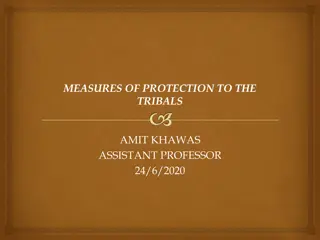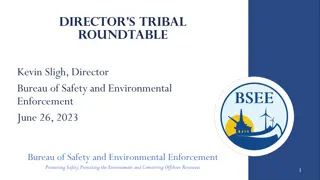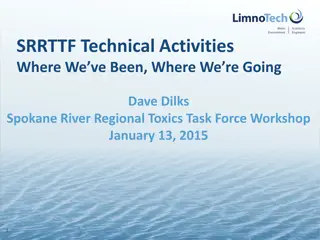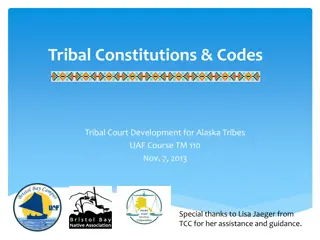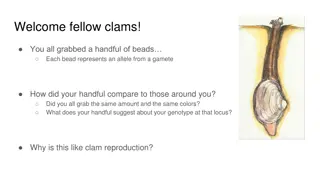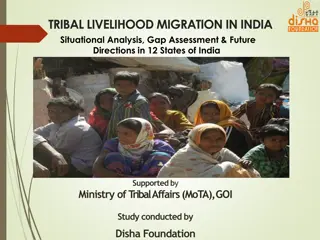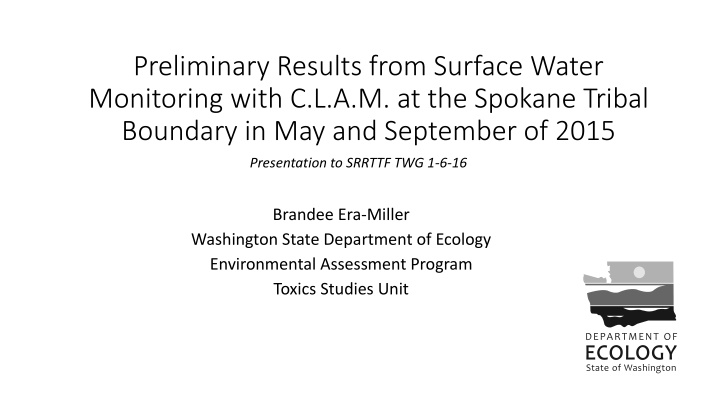
Surface Water Monitoring Results at Spokane Tribal Boundary - May & September 2015
Discover the preliminary findings from surface water monitoring conducted at the Spokane Tribal Boundary in May and September 2015 with the C.L.A.M. system. Results for total PCB congeners and PBDEs are presented, highlighting environmental signals and noise levels. The presentation outlines next steps for utilizing XAD-2 for upcoming sampling, including QA/QC measures and addressing potential limitations of the current method. Stay informed about the ongoing assessment and evaluation of toxins in the environment.
Uploaded on | 0 Views
Download Presentation

Please find below an Image/Link to download the presentation.
The content on the website is provided AS IS for your information and personal use only. It may not be sold, licensed, or shared on other websites without obtaining consent from the author. If you encounter any issues during the download, it is possible that the publisher has removed the file from their server.
You are allowed to download the files provided on this website for personal or commercial use, subject to the condition that they are used lawfully. All files are the property of their respective owners.
The content on the website is provided AS IS for your information and personal use only. It may not be sold, licensed, or shared on other websites without obtaining consent from the author.
E N D
Presentation Transcript
Preliminary Results from Surface Water Monitoring with C.L.A.M. at the Spokane Tribal Boundary in May and September of 2015 Presentation to SRRTTF TWG 1-6-16 Brandee Era-Miller Washington State Department of Ecology Environmental Assessment Program Toxics Studies Unit
Results for total PCB congeners: Results are within the noise of the C.L.A.M. sampling system (SPE disk housing contamination) Concentrations represent totals from Lab (need to blank correct per project objectives) Blanks shown are either Trip or Transfer (most comparable to samples) May 2015 September 2015 500 200 450 180 400 160 Picograms per Liter Picograms per Liter 350 140 300 120 250 100 200 80 150 60 40 100 20 50 0 0 20 L 20 L Blank CLAM CLAM 20 L 20 L Blank Blank CLAM CLAM CLAM
PCB Homologue Example: Mono and Di (lightest) and Nona and Deca (Heaviest) no environmental signal Tri through Octa appear to have potential environmental signal above the noise Still need to look at this for all samples 1400 1200 1000 800 20 liter C.L.A.M. from May 2015 600 400 200 0 Mono Mono Di Di Tri Tri Tetra Tetra Penta Penta Hexa Hexa Hepta Hepta Octa Octa Nona Nona Deca Deca Sample Blank Sample Blank Sample Blank Sample Blank Sample Blank Sample Blank Sample Blank Sample Blank Sample Blank Sample Blank
Results for PBDEs: Blanks shown are either Trip or Transfer (most comparable to samples) PBDE 47 appears to have strongest environmental signal above sampling system noise PBDE 99 and 209 are in the sampling system noise for half of the samples Still need to look at other PBDE congeners (40+) September 2015 May 2015 35 60 PBDE 47 PBDE 47 30 Picograms per Liter 50 Picograms per Liter 25 40 20 30 15 20 10 10 5 0 0 20 L 20 L Blank Blank CLAM CLAM CLAM 20 L 20 L Blank CLAM CLAM
What Next? Use XAD-2 instead of C.L.A.M. for upcoming January sampling: o See if results can get above the noise o Upcoming Ecology study using XAD-2 at same location (Will Hobbs) Apply blank correction per project objectives and TWG input Look for patterns and information in homologues & congeners Summarize study information on C.L.A.M. QA/QC: o Breakthrough SPE disk analysis o Characterization of PCB contamination from disk housing EAP still evaluating appropriate use of C.L.A.M. o May not be best tool for low-level PCBs o Stainless steel SPE disk housing o Waiting on results of AXYS blank study
How to Blank Correct? Report NJs per SRRTTF/LimnoTech QAPP, but do NJs get included in totals? If using NJs, then should we include NJ data in blank correction? Seems like a good idea. 3x blank rule used in SRRTTF/LimnoTech QAPP, but 3x rule is typically not used by labs. 5x and 10x are more typical. Examples below are from Spokane Tribal Boundary Monitoring Study. Row Sample ID 1 1509068-10 2 1509068-10 3 1509068-10 4 1509068-10 5 1509068-10 6 1509068-10 7 1509068-10 8 1509068-10 9 1509068-10 10 1509068-10 11 1509068-10 12 1509068-10 13 1509068-10 14 1509068-10 15 1509068-10 16 1509068-11 Parameter Name Result Qual UOM 21.8 B 27.8 32.6 B Blank Qual BtS Ratio 3x rule Qual 5x rule Qual 10x rule Qual Comment / Question 3.85 J 5.662338 21.8 21.8 2.5 J 27.8 27.8 3.88 J 8.402062 32.6 32.6 82.2 82.2 1.14 NJ 5.122807 5.84 5.84 0.72 NJ 2.430556 1.75 NJ 1.75 NJ 1.08 NJ 2.842593 3.07 J 3.07 J 0.5 UJ 1.5 J 1.5 J 2.69 NJ 3.022305 8.13 NJ 8.13 NJ 0.5 UJ 0.932 NJ 0.932 NJ 0.5 UJ 2.36 J 2.36 J 1.87 NJ 2.229947 4.17 4.17 0.5 UJ 0.5 UJ 0.5 UJ 0.5 UJ 0.5 UJ 0.5 UJ PCB-001 PCB-002 PCB-003 Censor Example Censor Example Censor Example Censor Example Homologue 5.84 or 5.84 U for 10x? 1.75 NJ or 1.75 U? 3.07 J or 3.07 UJ? 21.8 U 27.8 32.6 U 27.8 5.84 1.75 NJ 3.07 J 1.5 J 8.13 NJ 0.932 NJ 2.36 J 4.17 0.5 UJ 0.5 UJ pg/sample pg/sample pg/sample pg/sample pg/sample pg/sample pg/sample pg/sample pg/sample pg/sample pg/sample pg/sample pg/sample pg/sample pg/sample pg/sample Monochlorobiphenyls PCB-194 PCB-195 PCB-196 PCB-197/200 PCB-198/199 PCB-201 PCB-202 PCB-203 PCB-204 PCB-205 Octachlorobiphenyls PCB-183/185 5.84 1.75 NJ 3.07 J 1.5 J 8.13 NJ 0.932 NJ 2.36 J 4.17 0.5 UJ 0.5 UJ 8.13 NJ or 8.13 U for 5/10x? 4.17 or 4.17 U? Homologue total? 4.23 NJ and 4.23 U for 10x? 0.546 NJ 7.747253 4.23 NJ 4.23 NJ 4.23 NJ 4.23 NJ









